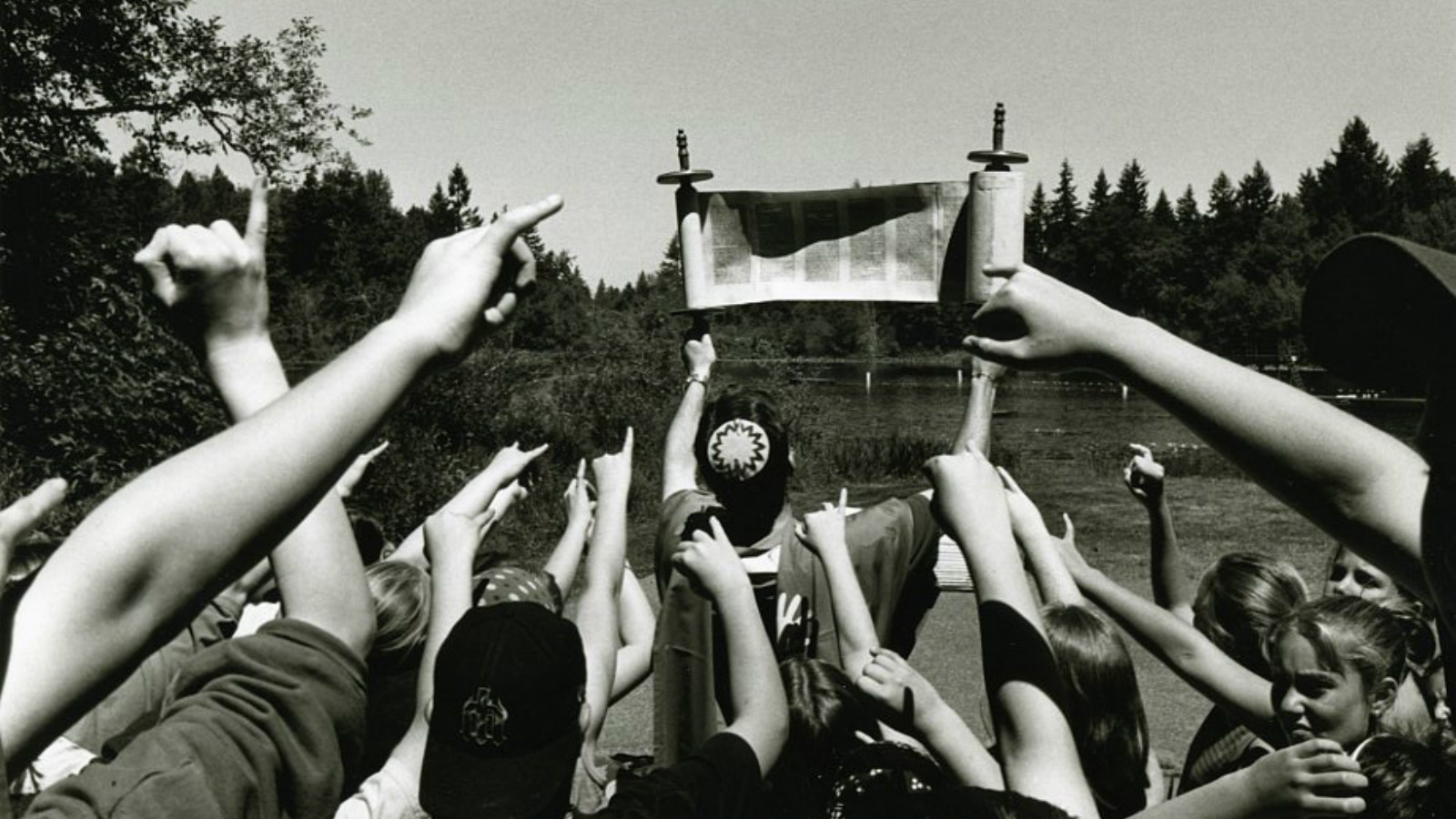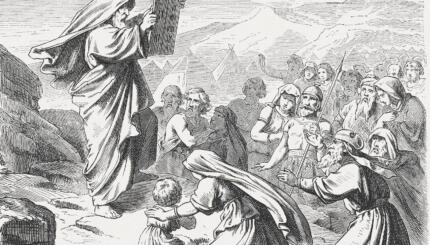Judaism is often said to be a religion of deed rather than of intention. Though overly simplistic, this description reflects the centrality of mitzvot (commandments) in Jewish life, as well as the rabbinic conclusion that, in most cases, a person who performs a mitzvah without focusing on its significance has nevertheless fulfilled his or her religious obligation.
This understanding of Judaism as a religion of action is encapsulated by the biblical verse in which the Jews standing at Mount Sinai signal their acceptance of the Torah with the words “na’aseh v’nishma“–“We will do and we will hear/understand.” In other words, the Jewish people promise first to observe the laws of the Torah, and only afterward to study these laws. In traditional Jewish culture, this statement has come to epitomize the Jewish commitment to the Torah.
Study vs. Action
Three separate biblical verses record the Israelites’ acceptance of the obligations that the Torah will impose on them, but only the last of these contains the now-famous phrase “na’aseh v’nishma.” When Moses first ascends to Mount Sinai, God commands him to tell the people that if they accept the covenant, God will make them a “kingdom of priests and a holy nation” (Exodus 19:6). Upon hearing these words, the people respond, “All that God has said, we will do” (19:8).
Later in the text, after Moses relates specific divine rules to the people, they again say, “All of the things that God has said, we will do” (24:3). A few verses later, after Moses writes and reads aloud the words of the Torah, the people utter the phrase “na’aseh v’nishma,” “We will do and we will hear” (24:7).
With your help, My Jewish Learning can provide endless opportunities for learning, connection and discovery.
The rabbinic tradition understands the words na’aseh v’nishma as a correction of the earlier promises simply to “do” what God has commanded. According to one midrash:
“‘And they [the Children of Israel] said, “all that God has said we will do and we will hear,”‘ since they had initially prioritized doing. Moses said to them, ‘Is doing possible without understanding? Understanding brings one to doing.’ They then said, ‘We will do and we will understand,’ [meaning] ‘We will do what we understand.’ This teaches that the people said ‘na’aseh v’nishma’ before receiving the Torah” (Mekhilta d’Rabbi Shimon bar Yochai 24:7).
This midrash reflects a classical rabbinic debate about the relative merits of study and action. In a well-known talmudic discussion, the rabbis conclude that “study is great, for it leads to action” (Kiddushin 40b). While emphasizing deed over study, the rabbis appear wary of promoting a religion by rote, in which people perform rituals without any understanding of the significance of these actions. In claiming that “understanding brings one to doing” or “study… leads to action,” the rabbis can prioritize action without negating the meaning of one’s actions. The insistence that “na’aseh” precedes “nishma” also allows for the creation of a coherent community unified by its practice, even while allowing for discussion about the details and significance of this practice.
Accepting Torah Before Sinai
The chronology of the revelation at Sinai is virtually impossible to unravel simply through a reading of the relevant biblical passages. Moses seemingly travels up and down the mountain continuously and presents the Torah to the Jewish people on several occasions. This confusing series of events leads numerous biblical commentators to invoke the rabbinic principle that “there is no chronology in the Torah”–meaning we cannot assume that events occurred in the order in which the Torah describes them.
This principle also allows the rabbis to insist that the Jewish people recited the words “na’aseh v’nishma” even before the revelation at Sinai. This unconditional acceptance of Torah, according to the rabbis, indicates the depth of the Jewish people’s commitment to God and their submission to divine law.
In placing the declaration “na’aseh v’nishma” before the revelation, the rabbis solve a problem created by their own biblical interpretation. According to the Bible, at the moment of revelation, “[the people] stood underneath the mountain.” According to the traditional interpretation of this strange biblical locution, God uproots Mount Sinai from the ground and holds it over the people, saying, “If you accept the Torah, fine; if not, here shall be your grave” (Talmud, Tractate Avodah Zarah 2b). The implication seems to be that the Jews accepted Torah only through coercion. The Rabbis eliminate this possibility by insisting that the people said “na’aseh v’nishma” before the revelation. Further emphasizing the voluntary nature of the Jewish submission to God and Torah, the Rabbis teach that the Jews accepted the Torah again at the time of the Purim.
Worthy of Torah
For the rabbis, the words na’aseh v’nishma also indicate the worthiness of the Jewish people for divine revelation. Several midrashim (interpretive stories) depict the angels, who often exhibit a sort of sibling rivalry toward the Jewish people, trying to persuade God that human beings, who are inherently imperfect, do not deserve to receive the Torah. This angelic argument finds support in the Torah’s own portrayal of the Jews as a whining and ungrateful people who construct a golden calf almost immediately after encountering God at Mount Sinai.
Nevertheless, the Talmud suggests that the people redeem themselves with the declaration “na’aseh v’nishma,” which demonstrates an understanding of certain divine secrets:
“At the moment when the Jewish people said first ‘We will do’ and then ‘We will understand,’ a heavenly voice went out and said to them, Who revealed to my children this secret, employed by the angels, as it is written, ‘Praise God, O God’s angels, mighty in strength, who do God’s will and understand God’s word ‘”(Tractate Shabbat 88a).
Just as the angels know first to obey and then to understand God’s word, so too the Jewish people have somehow intuited this divine secret and therefore have proven themselves as meriting the Torah, previously the exclusive property of the divine realm. Accordingly, in the Talmud, the angels respond to the people’s words by crowning each member of the Jewish people with two divine crowns, one for “na’aseh” and one for “nishma.”
While only Moses ascends to Mount Sinai, the collective Jewish people accepted the Torah. According to midrash, not a single member of the community missed the revelation for reasons of ritual impurity, and not a single person was blind, deaf, or otherwise unable to experience the totality of the revelation. Furthermore, according to some commentators, the words na’aseh v’nishma indicate an acceptance not only of the immediate laws of the Torah, but also of all of the laws to come. According to Abraham Ibn Ezra, “na’aseh [indicates] all of the laws given until this point [and] nishma [indicates] the laws to come in the future” (short commentary, comment to Exodus 24:7).
Though only one generation of Jews actually stood at Sinai, this group comprised the ancestors of all future members of the Jewish community., They accepted the Torah not only for themselves, but also for all generations to come. Each year at Shavuot, when Jews recreate the experience of the revelation, each generation has a new opportunity to declare on its own behalf, “na’aseh v’nishma.”
mitzvah
Pronounced: MITZ-vuh or meetz-VAH, Origin: Hebrew, commandment, also used to mean good deed.
Shabbat
Pronounced: shuh-BAHT or shah-BAHT, Origin: Hebrew, the Sabbath, from sundown Friday to sundown Saturday.
Talmud
Pronounced: TALL-mud, Origin: Hebrew, the set of teachings and commentaries on the Torah that form the basis for Jewish law. Comprised of the Mishnah and the Gemara, it contains the opinions of thousands of rabbis from different periods in Jewish history.
Torah
Pronunced: TORE-uh, Origin: Hebrew, the Five Books of Moses.



